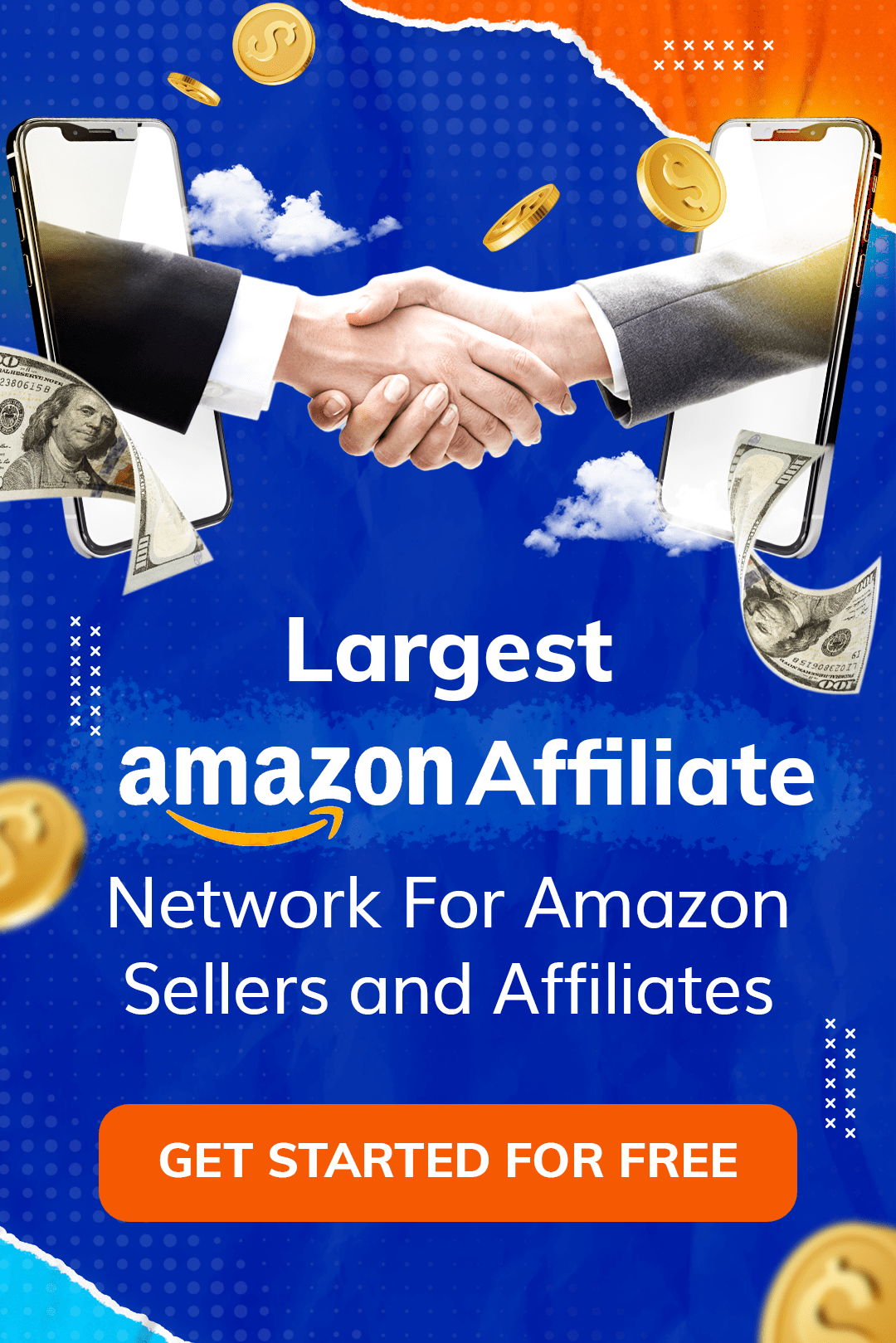Have you ever trusted a recommendation from a friend more than an advertisement? Ambassador marketing works on this simple idea.
It’s a strategy where loyal customers, fans, or influencers share their positive experiences with a brand so they can increase their brand’s visibility. These ambassadors speak from an original, real experience; their recommendations feel more real and relatable than regular ads.
This helps brands build stronger connections, earn trust, and grow a loyal community of supporters. More and more companies are using ambassador marketing because it creates authentic relationships that traditional advertising can’t match.
That is why, in this blog, we are explaining all you need to know about ambassador marketing. Stay tuned to know all about it.
What Is Ambassador Marketing?
What exactly is ambassador marketing? Is it related to brand ambassadors? Have you ever noticed how people trust friends or influencers more than ads?
Ambassador marketing is when brands work with people who really like their products. These people can be customers, employees, experts, or social media users. They share honest stories about the brand with their friends and followers.
Instead of regular ads, brands give ambassadors free products or special access so they can create real content. What makes ambassador marketing different is that it is real and ongoing. Ambassadors don’t just promote the brand once—they keep sharing their experiences over time.
This helps build trust and makes the brand feel more personal. Ambassador marketing turns real fans into helpers who talk about the brand on social media, write reviews, or tell others about it. Brands do this because honest voices from everyday people connect better than just celebrity ads.
Why Ambassador Marketing Is So Popular
Ambassador marketing is popular today because of brand ambassador programs and the growing desire for trust and real connections with people, not just ads. Many are tired of traditional ads and prefer hearing from real users. A brand ambassador shares honest stories and content that feels natural and relatable. This makes the brand message more personal and believable.
Ambassador marketing also builds a community. Brands create groups of loyal fans who feel connected and valued. These ambassadors often get behind-the-scenes access, which makes them more passionate about the brand.
Another reason ambassador marketing is growing is that it’s cost-effective. Instead of spending a lot on ads, brands get promotion through ambassadors who are often rewarded with products or discounts. This ongoing support usually brings better results and higher returns than one-time ads.
Last but not least, new technology makes it easy for brands to find ambassadors and reward them. All these reasons together explain why more brands are using ambassador marketing to build trust, community, and better business results.
What Are the Benefits of Ambassador Marketing?
Ambassador marketing helps both brands and customers in many ways, including:
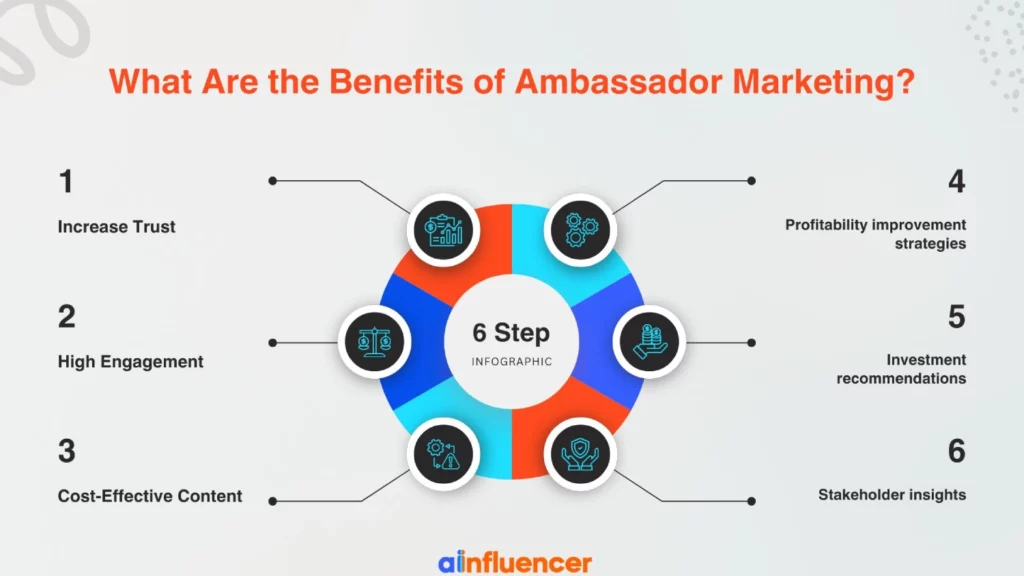
- Increase Trust: These days, people trust real users more than ads. Ambassadors share honest opinions and reviews that make others feel confident about the brand.
- High Engagement: Ambassadors share your brand with their friends and followers, so more people see it. Because ambassadors are real and honest, people pay more attention and interact more.
- Cost-Effective Content: Ambassadors make their own posts, videos, and reviews about your products. This means the brand doesn’t have to spend a lot on creating ads.
- Build Loyalty: Ambassadors feel special and connected to the brand. They keep buying from the brand and tell others about it, helping grow a group of loyal fans.
- Better Sales: When ambassadors share your brand, it leads to more sales. Many programs track sales to show that ambassador marketing works well.
- Helpful Feedback: Ambassadors share their ideas and insights, helping to shape what customers think and feel about a brand. This helps brands improve products and marketing.
Top 8 Ambassador Marketing Strategies
Want to grow your brand through people who genuinely love it? That’s what ambassador marketing is all about! Here’s how to create a strong and simple ambassador strategy.
1. Set Clear Objectives
Start by deciding what you want from your ambassador program. Be clear about your goals, is it brand awareness, higher sales, better engagement, or more user-generated content?
2. Identify Ideal Ambassadors
Think about who fits your brand best. Ambassadors can be loyal customers, social media macro and micro- influencers, employees, or community leaders. Choose people whose values match your brand.
3. Onboard Ambassadors
Once you know who you want, invite them to join. You can promote the program on your website or social media, or contact people directly. Be clear about the benefits they will get—free products, discounts, commissions, or swag—and explain what you expect from them.
Using a platform like Ainfluencer can make this step easier, more professional, and much more efficient.
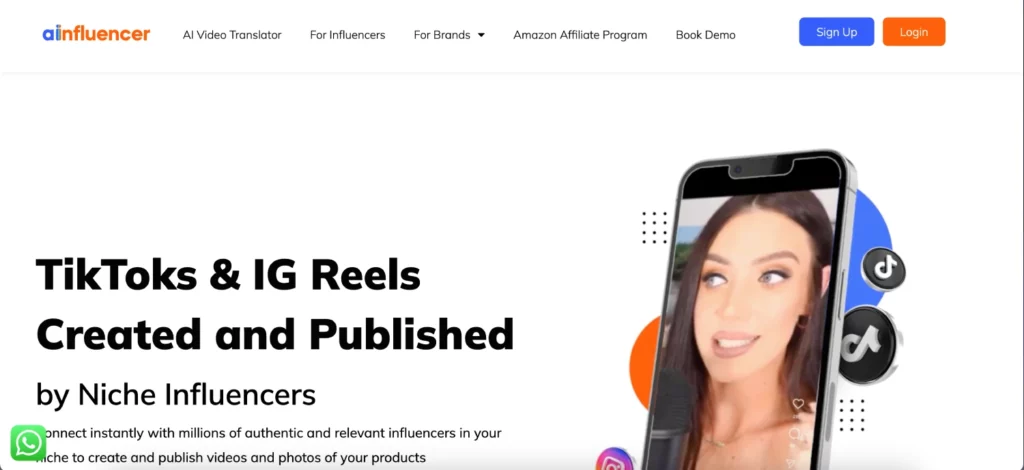
Ainfluencer is an all-in-one influencer and ambassador marketing platform that helps brands find, recruit, and manage ambassadors at scale. Instead of juggling spreadsheets, emails, and DMs, you can handle everything in one place.
With Ainfluencer, you can:
- Simplify the signup process with customizable application forms and automated onboarding.
- Manage rewards and incentives—track payouts, offer exclusive perks, or build tiered programs.
- Keep communication organized with built-in messaging tools and campaign briefs.
- Set clear expectations by outlining goals, deliverables, and timelines upfront.
- Track performance in real-time to see what’s working and who your top ambassadors are.
By giving your ambassadors a smooth, professional experience, you’re setting the tone for long-term loyalty and stronger brand representation.
Ready to launch your ambassador program with confidence?
Start with Ainfluencer!4. Provide Incentives
Ambassadors need motivation to stay active. Offer rewards like exclusive discounts, early access to products, cash commissions, gift cards, free products, or recognition by featuring them on your channels.
5. Encourage Authentic Content
Successful campaigns depend on real, honest content, not scripted ads. Let ambassadors be creative, but give them brand guidelines. Encourage them to share personal experiences, use your hashtags, make unboxing videos, or post how-to guides. Contests and challenges can also motivate content creation.
6. Leverage an Ambassador Platform
Managing ambassadors by hand can get complicated as your program grows. Many brands use software to help with recruiting, communication, content tracking, and payments.
7. Integrate with Other Marketing
Ambassador programs work best when part of your overall marketing plan. Ambassadors can promote campaigns on social media, contribute to email newsletters, create content for ads, or attend events.
8. Measure and Optimize
Keep track of how your program is doing by monitoring key metrics. Use this information to improve your strategy. Some ambassadors may perform better, or certain content may get more engagement.
The Most Inspiring Ambassador Marketing Examples
Here are a few real-life examples that show how companies use ambassadors to grow their brand.
- HelloFresh – Referral Ambassadors: HelloFresh certainly knows how to collaborate with influencers and happy customers. Their food ambassadors post recipe videos, share discount codes, and earn money for every new person who signs up.

- Nike – Athlete Ambassadors: Nike teams up with both famous athletes and everyday fitness fans. They wear Nike gear, post about their workouts, and help promote the brand with real-life stories and trust.
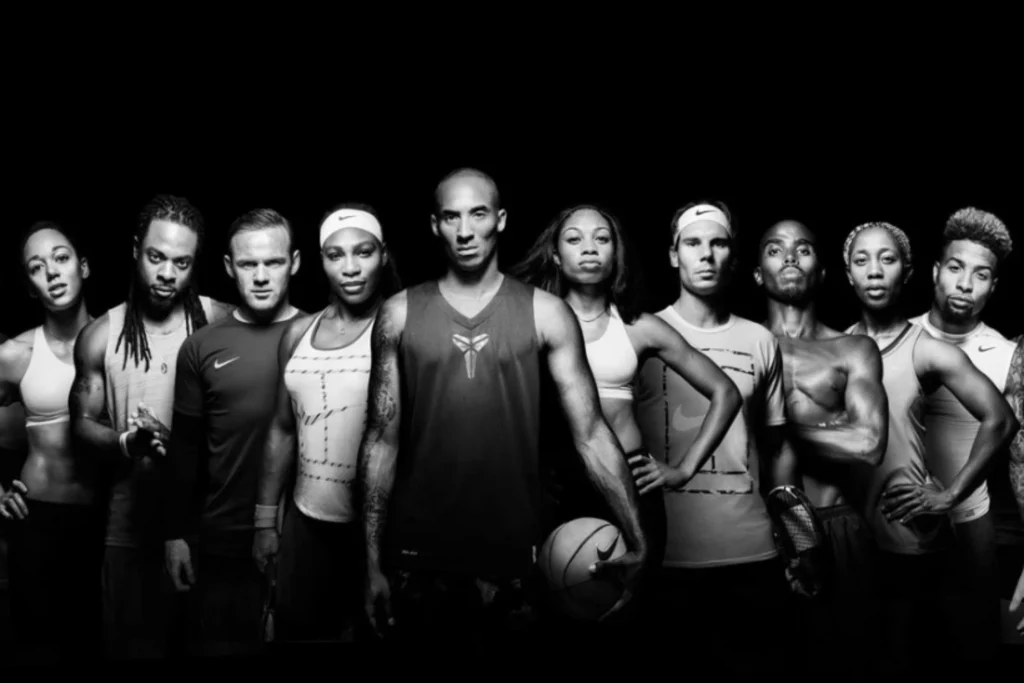
- Red Bull – Student Marketeers: Red Bull picks college students to give out free drinks and promote the brand at campus events. Students get free Red Bull, cool gear, and training. Today, they have over 4,000 student ambassadors worldwide.

- Glossier & Gymshark – Social Influencer Ambassadors: These brands use social media fitness influencers to post product reviews, demos, and workout videos. They also share promo codes, which helps the brand grow in specific communities.

- IBM and Google – Employee Ambassadors: These tech companies ask employees to share company news online or speak at events. Employees help build trust because they know and believe in the brand.

- Patagonia & REI – Outdoor Community Ambassadors: These brands work with outdoor influencers like hikers and climbers. Ambassadors create content about adventures and protecting the environment, which fits the brand’s mission.

What Are the Best Ambassador Marketing Metrics to Measure?
To know if your ambassador marketing efforts are paying off, track these important metrics:
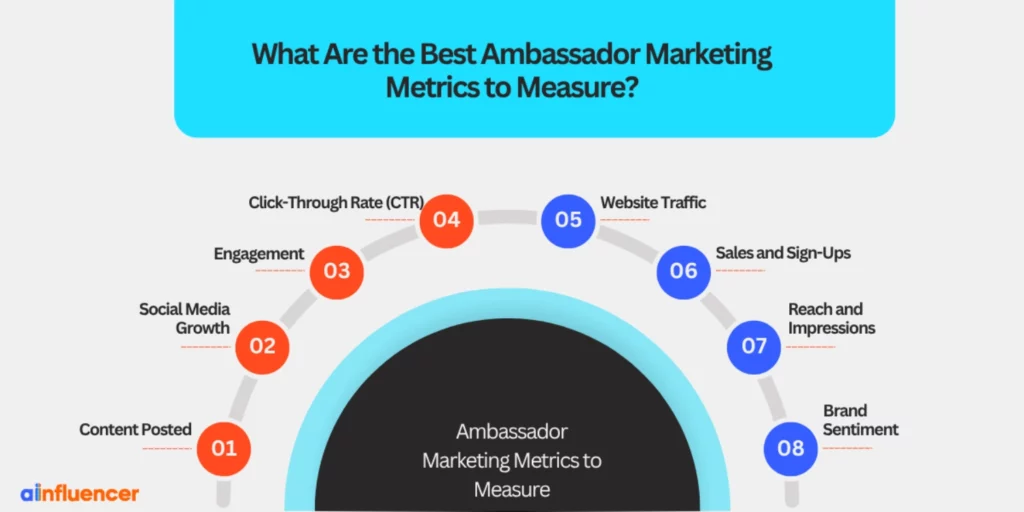
- Website Traffic: Use tools for Google Analytics or UTM links to see if ambassadors are sending people to your website.
- Sales and Sign-Ups: If you give ambassadors referral codes or links, count how many purchases or sign-ups they bring in.
- Reach and Impressions: Check how many people are seeing the posts. This tells you how much attention your brand is getting.
- Brand Sentiment: Read the comments and feedback. This helps you understand how people feel about your brand.
- Click-Through Rate (CTR): Look at how many people click the links in ambassador posts. A higher CTR means more people are interested in learning more.
- Engagement (Likes, Comments, Shares): See how many people are liking, sharing, or commenting on your ambassadors’ posts. More engagement means the audience is interested.
- Social Media Growth: Keep track of how many new followers you gain, how often your brand is mentioned, and if more people are using your hashtags.
- Content Posted: Measure how much content your ambassadors are creating—like posts, photos, videos, or reviews.
Conclusion
Ambassador marketing is a powerful way to grow your brand through real people who genuinely love your products. It builds trust, creates authentic content, and delivers strong results without the high costs of traditional ads. To succeed, focus on clear goals, choose the right ambassadors, and give them the tools and rewards they need. Don’t forget to track your results so you can keep improving.
Tools like Ainfluencer make the whole process easy. It’s free, uses smart AI to match you with ambassadors, and helps manage everything from payments to performance tracking—all in one place.
With the right approach and the right platform, ambassador marketing can become one of your best growth strategies.
FAQs
You can start small with little or no cost. Many brands give free products or discounts as rewards. The main cost is usually the rewards or commissions for ambassadors. Some tools are free to use, so you only pay ambassadors when they get results.
Look at how many likes, comments, and shares ambassadors get. Check if more people are visiting your website or buying products through referral links. Keep an eye on brand mentions and customer feedback to see how people feel about your brand.
First, set your goals. Then choose ambassadors who match your brand and have active followers. Offer rewards like free products or discounts. Give them clear guidelines and support. Use a tool to help you manage everything and track results. Stay in touch and build strong relationships over time.
Ambassador marketing is about people who truly like your brand and want to support it for a long time. They often get rewards like free products, discounts, or cool gifts, and they talk about your brand because they believe in it.
Influencer marketing is usually shorter. Someone is paid to post about your product once or just for a short time. Influencers are great for getting quick attention and reaching new people fast.
Both can be really helpful. Ambassadors give you long-term support and trust, while influencers help spread the word quickly. Using both together can be a smart way to grow your brand.

